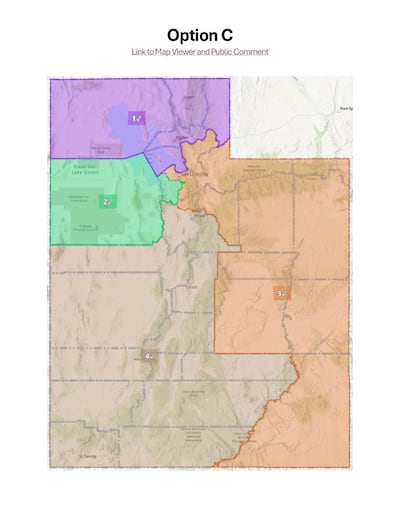- The Legislative Redistricting Committee voted to recommend Option C to the Utah Legislature.
- Option C is one of five maps that were presented by the committee.
- This vote follows a 10-day public comment period required by the judge.
Utah’s Legislative Redistricting Committee early Monday voted to favorably recommend Map C for consideration by the rest of the Utah Legislature.
Map C will be presented to the rest of the Legislature later in the day for a vote. The state Legislature is holding a special session on Monday which was called by Gov. Spencer Cox.
Following a 10-day public comment period for proposed congressional maps, the redistricting committee held its last public meeting to choose a map.
Monday’s special session will address a variety of issues, including submitting a congressional map for consideration by 3rd District Court Judge Dianna Gibson.
This map redrawing comes after a Utah Supreme Court ruling last year, saying the Utah Legislature shouldn’t have been allowed to amend 2018’s Proposition 4, also known as the Better Boundaries initiative.
“We’ve put a lot of consideration in all of these maps, and I think this map best suits the citizens of Utah to put the rural and the one vote per person,” said Sen Don Ipson, R-St. George. “And I think this is the map that suits the people best.”
Better Boundaries Executive Director Elizabeth Rasmussen attended Monday’s meeting, and spoke with The Deseret News about the outcome.
“We weren’t surprised. We thought this would happen. We’re disappointed in this outcome, and it’s just disappointing,” she said.

Last month, Gibson ruled that with the initiative’s standards back in place, the existing congressional map cannot be used in the 2026 election since it does not meet Proposition 4’s requirements. The ruling requires the congressional map to be redrawn.
Map C was one of five maps proposed by the committee and there were more than 100 maps that were also submitted by members of the public for consideration.
Last week, the Utah GOP sent an email to donors and delegates urging them to submit comments in support of “Option C,” one of the six proposed maps that Republicans believe would offer their strongest chance to maintain control of all four of Utah’s House seats.
What was said about Option C
Ahead of the committee’s vote on Option C, Rep. Stephanie Gricius, R-Eagle Mountain spoke in favor of the map highlighting how she appreciates the distribution of the state’s military installments in the map.
The eight Republican members of the committee voted in favor of the map, Sen. Luz Escamilla D-Salt Lake City and Rep. Doug Owens, D-Millcreek, voted against it.
Rasmussen also spoke about the Utah GOP asking people to comment on Option C last week: “It’s frustrating, because we’ve been very clear that we want full representation for Utahns, and all we’ve done is help Utahns engage in the process, and yet, we’re seeing partisanship injected into this process, and it’s just really disappointing,” she said.
What are maps supposed to look like under Proposition 4?
There are eight standards listed by Proposition 4 that should be followed by any proposed congressional map:
- Equal population
- Minimize municipal splits
- Minimize county splits
- Compactness
- Contiguity and ease of transportation
- Preserve traditional neighborhoods and communities of interest
- Follow natural and geographic features and boundaries
- Maximize boundary agreement among different types of districts
These standards are also meant to be prioritized in the order listed, per the ruling.
One of the standards that has been discussed multiple times in committee meetings is prioritizing minimizing the amount of municipal and county splits.
Here is a look at the the splits in Option C:
Municipal splits: Millcreek, North Salt Lake, Pleasant Grove
County splits: Davis, Salt Lake, Utah
As a part of Proposition 4 the committee wasn’t allowed to consider any partisan data.
“We asked, out an abundance of caution that the staff review all of the public comments and make sure that they did not forward to this committee anything that dealt with the partisan numbers data or reference to partisanship, and we still received 1000s of comments. I reviewed hundreds of pages of comments on different maps,” said committee chair Scott Sandall, R-Tremonton.
One question that was asked multiple times online and during committee meetings is why the committee isn’t using the maps that were drawn by the Independent Redistricting Commission in 2021.
Committee Chairs Rep. Candice Pierrucci R-Herriman and Sandall shared that Gibson’s order said those maps were not allowable in this setting because the IRC was following SB200 and not Prop 4 when drawing the maps.
Another request that was made repeatedly during online public comment is to not split Salt Lake County, Sandall emphasized that this is not possible under federal law.
The ideal population of districts under federal law is the state’s population divided by the number of districts. Utah’s total population is 3,271,616 and divided by four the ideal population in each district is 817,904.
Salt Lake County’s population is 1,185,238, bigger than the ideal population, meaning the county has to be split in order for the state’s population to be divided evenly between the four congressional districts.

